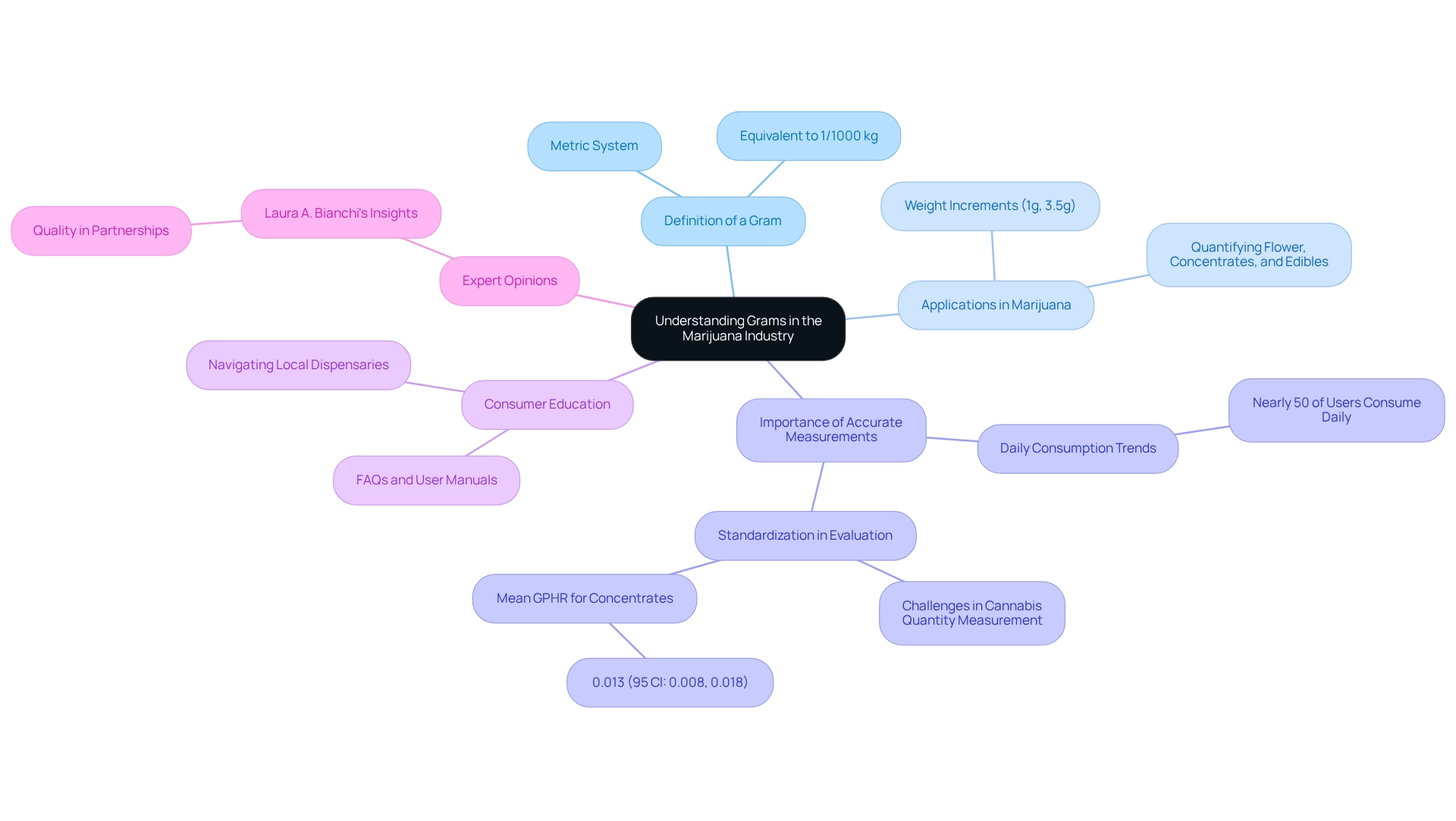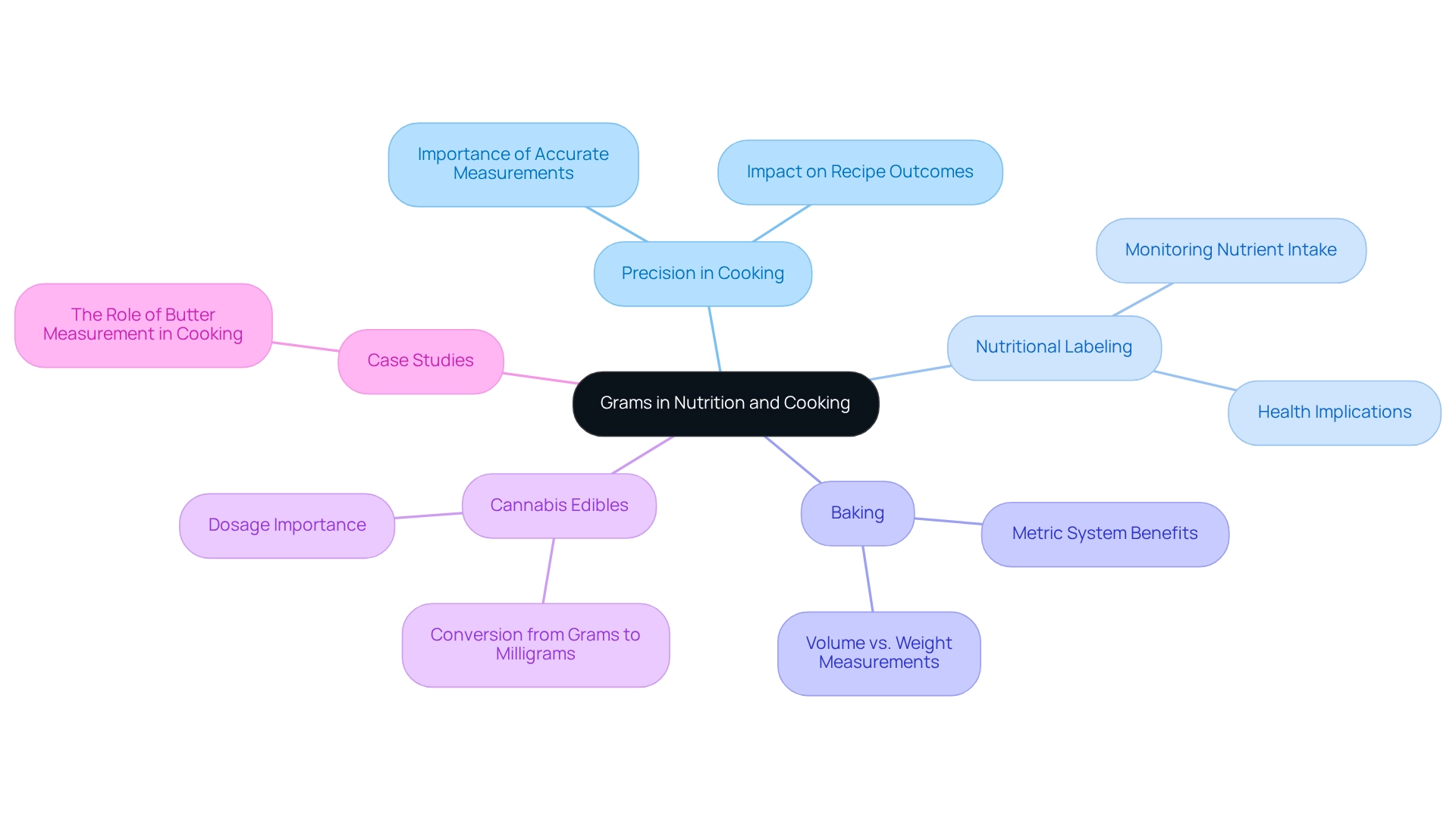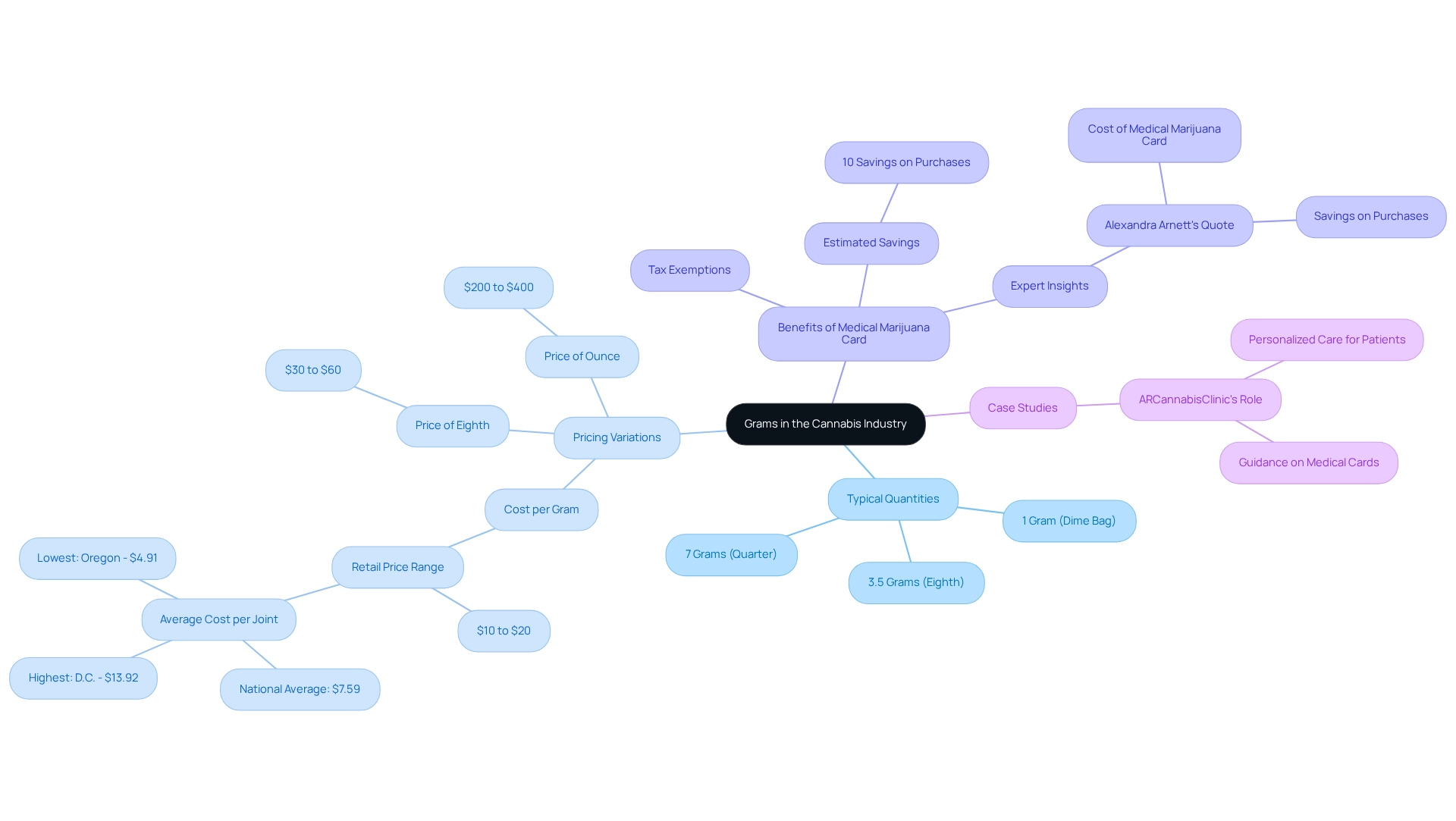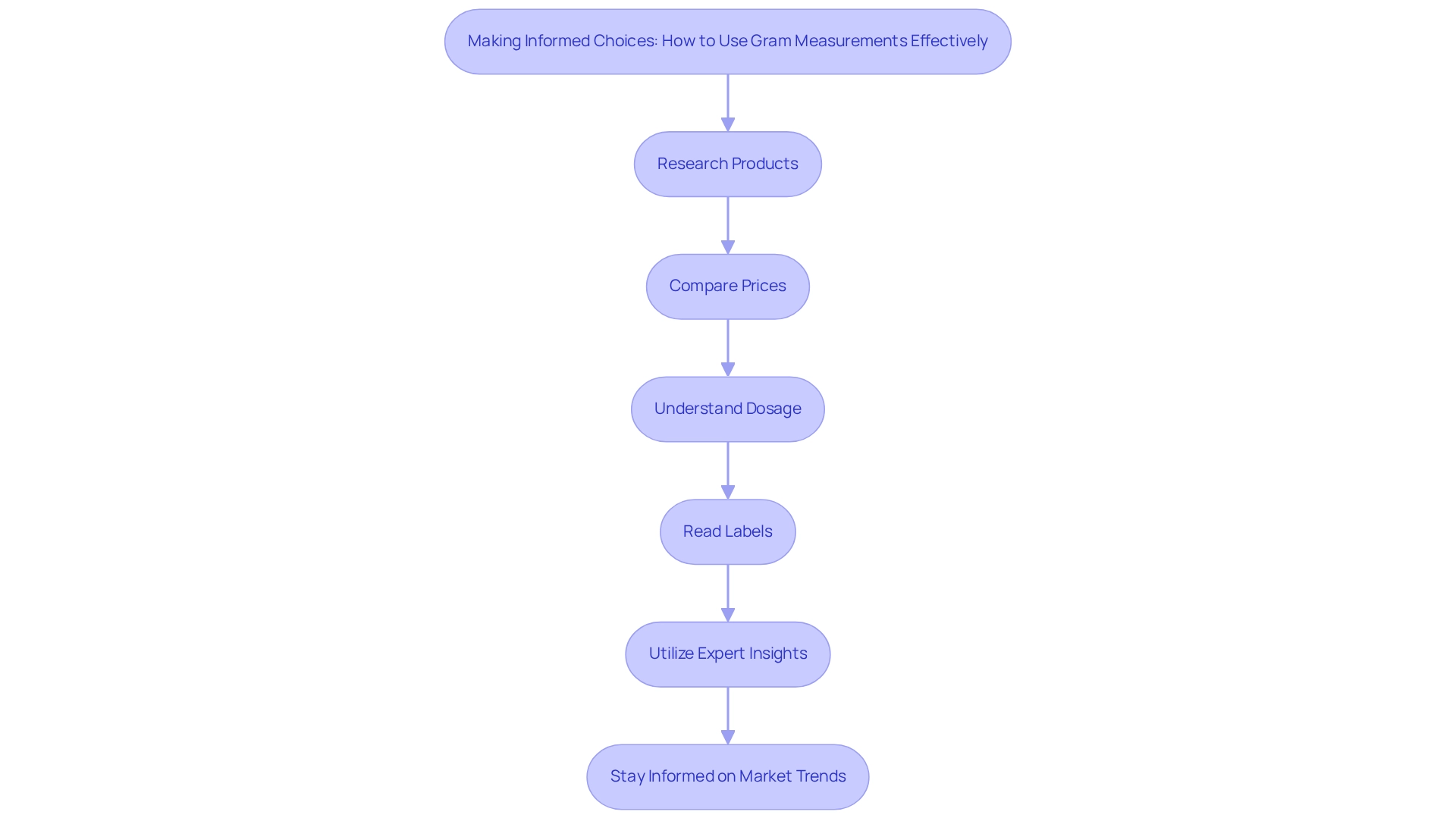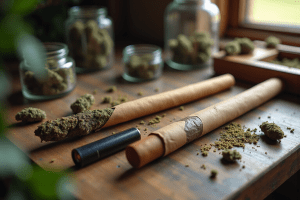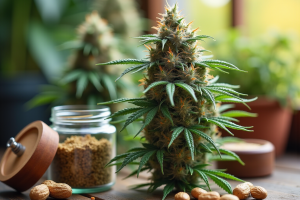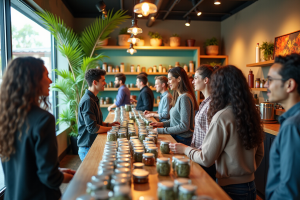Overview
This article serves as a caring guide on understanding how much a gram is, highlighting its importance in both the cannabis industry and culinary practices.
Why does knowing this matter? Accurate measurements empower consumers, ensuring that you can make informed choices.
We delve into various aspects such as conversions and proper weighing techniques, making it relatable and easy to grasp. Additionally, we explore how grams impact pricing and legal regulations, equipping you with the tools to navigate these areas confidently.
Together, let’s embrace the knowledge that allows us to make thoughtful decisions when purchasing products.
Introduction
In the intricate world of cannabis and culinary arts, grams play a crucial role as a unit of measurement, influencing everything from product pricing to recipe precision. Have you ever wondered how understanding this metric can empower you? It not only helps you make informed decisions but also enhances your overall experience, whether you’re selecting the perfect strain at a dispensary or crafting a delectable dish in your kitchen.
As the cannabis industry continues to evolve, the importance of grams becomes increasingly clear. Their influence extends to how products are sold, consumed, and regulated. This article invites you to explore the essential aspects of grams, examining their role in cannabis consumption and cooking. Together, we will uncover the significance of accurate measurements, equipping you with the knowledge necessary to navigate this complex landscape effectively. Let’s embark on this journey together, enhancing our understanding and experiences in the world of cannabis and culinary delights.
Understanding the Basics of Grams: What Is a Gram?
A unit of measurement in the metric system is equivalent to one thousandth of a kilogram. This measurement is commonly used for assessing small amounts of various materials, including food components and marijuana items. To put this into perspective, a standard paperclip weighs roughly one unit. In the marijuana sector, these units serve as a fundamental measure for quantifying the weight of flower, concentrates, and edibles. Understanding this measurement is essential for consumers when purchasing items.
Comprehending measurements is especially crucial, considering that almost 50% of marijuana users partake daily. Consumption trends are frequently shaped by changing marijuana regulations, emphasizing the importance of access to high-quality items quantified precisely in grams. For instance, a standard dispensary might offer items in different weight increments, such as 1g or 3.5g (an eighth), allowing customers to select according to their needs and preferences.
At Leafy Mate, we provide an extensive directory to help you find local dispensaries offering a varied range of high-quality marijuana products suited to your preferences. We want to ensure you locate exactly what you require.
Real-world examples illustrate the significance of grams in marijuana consumption. A study on the challenges of cannabis quantity assessment revealed that precise evaluation is vital for understanding the biopsychosocial effects of cannabis use. The research highlighted the necessity for standardized evaluation strategies, particularly for flower and concentrate products. This improvement can enhance communication of scientific results and bolster consumer understanding.
Significantly, the average units per hour of concentrates (GPHR) was determined to be 0.013, underscoring the importance of accurate measurements in consumption.
Expert viewpoints also emphasize the significance of measurements in the cannabis sector. Industry experts point out that a clear understanding of grams can empower consumers to make informed choices, ensuring they select the right items for their needs. Laura A. Bianchi, a founding partner of Bianchi & Brandt, stated, “Others are entering into poor partnerships out of desperation, and we will likely see them in court in the future.” This highlights the essential nature of quality in evaluating partnerships within the industry.
This educational approach aligns with Leafy Mate’s mission to enhance resource accessibility and promote responsible use of marijuana.
In summary, a gram is not merely a unit; it plays a crucial role in the marijuana industry, influencing how items are traded and utilized. By becoming acquainted with this measurement, consumers can navigate the intricacies of the marijuana market more efficiently, ensuring they make knowledgeable decisions when visiting local dispensaries. For additional assistance, Leafy Mate also offers FAQs and user manuals to help new cannabis users understand product dimensions and make informed choices.
Why Grams Matter: Applications in Nutrition and Cooking
Grams play a crucial role in both nutrition and cooking, often raising the question of how much is a gram. This standard unit ensures precision and consistency in ingredient quantities, which is vital for achieving the preferred taste and texture in meals. Recipes typically indicate quantities in units to aid precise reproduction. For instance, during baking, even minor differences in ingredient amounts can significantly influence the outcome. This precision leads many chefs and home cooks to prefer using accurate weights.
Culinary experts advocate for the metric system in baking and charcuterie, highlighting how it can simplify calculations and enhance accuracy. Have you ever wondered how much easier cooking could be with straightforward measurements?
In the realm of nutrition, food labels prominently display nutrient content in grams, allowing consumers to monitor their intake of proteins, fats, and carbohydrates effectively. This level of detail is particularly beneficial for those with dietary restrictions or specific health conditions, enabling informed choices about food consumption. Recent studies suggest that accurate assessments can lead to improved dietary adherence, which is essential for managing health outcomes.
Consider this: boiling water reaches a temperature of 100 °C at sea level. This example illustrates the significance of accurate readings in cooking methods.
When it comes to marijuana, understanding how much is a gram is crucial for achieving the intended strength and effects in edibles and tinctures. Grasping the conversion from grams to milligrams of active substances can substantially influence the final outcome. This precision not only enhances the cooking experience but also ensures that consumers can enjoy their products safely and effectively.
User guides frequently stress the importance of dosage when making cannabis edibles, underscoring that precise quantities can prevent overconsumption and improve the overall experience. Have you ever faced challenges in measuring ingredients accurately? Case studies further demonstrate the significance of weight in cooking; for example, the measurement of butter in American recipes often uses sticks labeled with tablespoons, making it convenient. However, this method can lead to inconsistencies when recipes require precise amounts, highlighting the need for a more standardized approach.
The case study titled “The Role of Butter Measurement in Cooking” examines how butter is packaged and measured. It concludes that while the American system has its advantages, there is room for improvement in enhancing consistency and ease of use in recipes.
Ultimately, the focus on weight in both nutrition and cooking indicates a broader trend towards precision and responsibility in food preparation and consumption. As nutritionists promote the significance of quantifying in units of weight, understanding how much is a gram becomes a vital element of responsible cooking and eating. Lopez-Alt’s harmonious method for recipe proportions, suggesting volume for smaller servings and weight for larger quantities, further emphasizes how much is a gram in achieving culinary accuracy, particularly in the making of marijuana edibles.
As cannabis legalization progresses, comprehending these metrics becomes ever more crucial for consumers navigating the evolving landscape of cannabis products. Together, let’s embrace the journey towards more informed and responsible cooking choices.
The Importance of Accurate Measurements: How to Measure Grams Correctly
To measure weight precisely, it’s important to understand how much a gram is when using a digital scale. Let’s explore some steps together to ensure you achieve the best results:
- Calibrate the Scale: Before placing any items on the scale, make sure it is set to zero. This step is essential for accurate measurements.
- Use a Container: If the substance you’re weighing requires a container, weigh the empty container first. After noting this weight, reset the scale to zero to account for the container’s weight.
- Incorporate the Component: Gradually introduce the component until you reach your desired weight. For example, if you need to measure a gram of flour, continue adding flour until the scale shows 50 grams.
- Always verify your measurements to ensure precision, especially when preparing food or administering substances. Consistency in your weighing routine can greatly enhance the reliability of your results.
Digital scales with a readability of 0.2 lb. can provide more precise weight values compared to those with a 0.5 lb. readability, making them ideal for accurate dosing.
As noted by Justine Frija-Masson, MD, DPhil, “The goal of the research was to determine the accuracy of 3 commercially available smart scales for weight and body composition compared with dual x-ray absorptiometry (DEXA) as the gold standard.” Understanding factors that influence scale accuracy, such as the type of flooring and foot placement, is crucial, as highlighted in a study exploring these variables. By following these guidelines, you can ensure that your measurements are both precise and consistent, which is essential for effective dosing of the substance.
Converting Grams: Understanding Other Measurement Units
An essential ability in both cooking and cannabis usage is knowing how much is a gram when transforming weights into other units. This knowledge ensures precision in recipes and product application, which is vital for a rewarding experience. Here are some crucial conversions to consider:
-
Grams to Ounces: To change grams to ounces, divide the quantity of grams by 28.35. For example, 100 units converts to roughly 3.53 ounces. This conversion is especially helpful when measuring marijuana, as it aids in understanding how much is a gram, especially since many products are sold by the ounce. It’s important to note that the price of marijuana can vary from approximately $1 to $15 or higher per unit. This variability leads consumers to wonder how much is a gram, making precise measurements financially important.
-
Grams to Kilograms: To change grams to kilograms, simply divide by 1,000. Thus, 1,000 units corresponds to 1 kilogram. This transformation is frequently essential when buying larger amounts of marijuana or components.
-
Grams to Milligrams: To change grams to milligrams, multiply by 1,000. Thus, 1 unit is equivalent to 1,000 milligrams. This transformation is particularly significant in the marijuana sector, where knowing how much is a gram is crucial for accurate dosing for both medicinal and recreational consumers.
Grasping these conversions is vital for correctly adhering to recipes or understanding item labels. For instance, in marijuana cooking, knowing how much is a gram and understanding how to change units from grams to ounces can assist users in figuring out the appropriate quantity of marijuana to incorporate in their recipes. This ensures a harmonious and pleasurable experience.
As emphasized in the case study of Leafy Mate, the platform helps users explore the marijuana sector by offering personalized suggestions for strains and products. This underscores the significance of precise calculations in product use, fostering a supportive environment.
As the marijuana market continues to develop, consumers often need to change grams to other measurements. These skills are essential for making informed choices. As Imene, a recipe creator, highlights, accurate quantities are essential for successful cooking, whether in the kitchen or when making cannabis-infused dishes. Together, we can ensure that our culinary adventures are both enjoyable and precise.
Grams in the Cannabis Industry: What Consumers Need to Know
In the cannabis sector, units serve as the fundamental measure for acquiring products. Understanding how much is a gram in terms of weight and pricing is crucial for consumers navigating this market, especially for those considering the financial benefits of obtaining a medical marijuana card. Here are some key points to consider:
- Typical Quantities: Cannabis is frequently sold in various gram quantities, with common options including 1 gram (often referred to as a ‘dime bag’), 3.5 grams (an eighth), and 7 grams (a quarter). These measurements help us determine how much is a gram of the product we are purchasing and how it fits into our consumption needs.
The cost per unit, including how much is a gram, can vary considerably depending on elements like quality and geographical location. Generally, we can expect to pay between $10 and $20 for each unit. For example, the national average price for a high-quality joint, which usually contains around 0.66 units, raises the question of how much is a gram, with the price being approximately $7.59. However, prices can vary widely, with the highest average cost found in the District of Columbia at $13.92 per joint, while states like Oregon offer more affordable options, averaging around $4.91. This geographical pricing variation is crucial for us to consider when making purchases, especially since having a medical marijuana card can lead to estimated savings of upwards of 10% on these purchases, which again raises the question of how much is a gram.
Understanding how much is a gram of marijuana is essential for evaluating the strength and overall worth of the products. This knowledge empowers us to make informed purchasing decisions, ensuring we receive the quality we expect for our investment.
In dispensaries, how much is a gram often reflects the quality and brand of the cannabis. For instance, while a unit may cost between $10 and $20, an eighth can range from $30 to $60. If you are curious about how much is a gram, it can be determined from these prices. This tiered pricing system emphasizes the significance of comprehending measurement units, particularly how much is a gram, when assessing overall expenses. Additionally, obtaining a medical marijuana card can lead to significant savings on these purchases, as cardholders often benefit from reduced prices and tax exemptions, making it easier to determine how much is a gram and further enhancing their financial advantages.
Expert insights from industry specialists stress that understanding how much is a gram of marijuana sold by weight can greatly influence our decisions. As Alexandra Arnett highlights, ‘What is the price of a medical marijuana card, how much can you save on purchases, and how much is a gram of the product do you need to buy to balance the expenses?’ This perspective underscores the financial considerations we must keep in mind. Additionally, the case study on ARCannabisClinic demonstrates how comprehending weight units can assist patients in making knowledgeable choices regarding their purchases while enhancing their savings through a medical card.
By understanding these essential elements of weight measurements and the financial advantages of a medical marijuana card, including anticipated savings and tax benefits, we can navigate the marijuana market more efficiently. Together, we can ensure that we make informed decisions that match our preferences and budgets.
Legal Considerations: Understanding Grams in Cannabis Regulations
Legal rules regarding marijuana often outline possession thresholds based on weight, which raises an important question: how much is a gram? These thresholds can vary significantly from one state to another, and it’s essential to understand them.
Possession Limits: Many states have established specific limits on the amount of cannabis that adults can legally possess. For instance, in Illinois, adults are permitted to have up to 30 units of marijuana flower. This regulation aims to promote responsible use while ensuring compliance with state laws. Knowing how much is a gram is vital for navigating marijuana dispensaries effectively.
Buying Guidelines: Dispensaries typically offer marijuana items quantified in units, making it crucial for buyers to understand these units. This knowledge not only aids in making informed purchases but also ensures adherence to local regulations. For example, in Alaska, the total quantity of THC from all items—flower, concentrates, and edibles—cannot exceed 5.6 units. This limit highlights the importance of being aware of both weight and potency, as consumers must navigate these regulations responsibly, particularly regarding how much is a gram.
Types of Cannabis Products: Dispensaries provide a variety of cannabis products, including:
- Flower (buds)
- Edibles (e.g., gummies, chocolates, beverages)
- Concentrates (e.g., shatter, wax, oils)
- Vape cartridges
- Topicals (e.g., creams, balms, lotions)
- Tinctures
- CBD products
Impact of Legalization: As cannabis laws evolve, staying informed about the legal implications of gram measurements is crucial for responsible consumption. The St. Regis Mohawk Tribe in New York, which legalized both medical and recreational marijuana in June 2021, allows personal cultivation of up to twelve plants and has established a dispensary license program. This legislation enables the tribe to regulate marijuana trade on their land, fostering economic growth and self-governance. This case illustrates how local regulations can significantly influence possession limits and consumer rights.
Current Legal Possession Limits: Understanding the current legal possession thresholds of marijuana in units by state is essential. While some states may allow higher possession limits, others may impose stricter regulations. It is vital to consult local laws to ensure compliance. Additionally, the legal landscape surrounding CBD oil indicates that in certain states, it may only be legal to contain up to 0.5% THC, underscoring the need for awareness of specific regulations that can affect possession limits.
Expert opinions from legal specialists emphasize the importance of understanding possession limits, particularly how much is a gram. As Rosanna Smart from the RAND Corporation noted, “Current U.S. State Cannabis Sales Limits Allow Large Doses for Use or Diversion.” This insight reinforces the necessity for consumers to be informed about the complexities of marijuana laws, as regulations can vary widely.
By familiarizing yourself with these regulations, you can make informed decisions and engage responsibly in the marijuana market. Together, we can navigate this evolving landscape. Leafy Mate is committed to providing educational materials that empower users to manage these complexities effectively, connecting them to reliable medical marijuana physicians and reputable marijuana brands.
Making Informed Choices: How to Use Gram Measurements Effectively
To make informed choices regarding grams, let’s explore some essential tips together:
-
Research Products: Before making a purchase, it’s important to dive into the specifics of the strain you are considering. Understanding its effects, flavor profile, and potential benefits can help ensure it aligns with your needs and preferences. A case study titled ‘Quality by Source’ found that dispensaries are often rated highest in quality, underscoring the importance of selecting reputable sources when buying marijuana. Leafy Mate connects you to high-quality, trusted marijuana brands, ensuring you have access to the best options available.
-
Compare Prices: Take the time to conduct a thorough price comparison per unit across various dispensaries. This not only helps you identify the best deals but also allows you to gauge how much is a gram, as the average market price can vary significantly based on location and supplier. As Participant #6 shared, “When I buy bigger amounts, I find that I smoke more,” highlighting how purchasing in larger quantities can influence consumption habits. Leafy Mate’s resources can assist you in finding competitive pricing from reputable sources.
-
Understand Dosage: If you’re using marijuana for medical purposes, it’s crucial to know how much is a gram and consult with a healthcare professional. They can provide guidance on the appropriate dosage, ensuring that you use cannabis safely and effectively. Leafy Mate can help connect you with medical marijuana doctors who can offer personalized advice.
-
Read Labels: Always take a moment to scrutinize item labels for weight and potency information. This practice ensures that you receive the quality and quantity you expect, helping you avoid any unpleasant surprises. The credibility of the item’s quality is further supported by a quality assessment completed by two reviewers (JD, OS), reinforcing the significance of informed purchasing decisions.
-
Utilize Expert Insights: Engage with marijuana professionals who can offer valuable advice on using grams effectively. Their knowledge can assist you in making informed buying choices, especially when navigating the intricacies of marijuana products. Leafy Mate offers access to knowledgeable experts who can enhance your understanding of the advantages of marijuana.
-
Stay Informed on Market Trends: Keep an eye on consumer research habits and trends in the marijuana market. Understanding how other consumers approach their purchases can provide valuable insights into making your own decisions. For instance, Slovenia’s recent advancements in marijuana legalization, permitting adults to cultivate plants at home, reflect the evolving landscape that may influence consumer behavior and purchasing choices.
By mastering the concept of grams and learning how much is a gram through Leafy Mate’s educational resources, we can navigate the cannabis market with confidence, ensuring that our purchases are both informed and satisfying.
Conclusion
Grams serve as a crucial unit of measurement that profoundly impacts both the cannabis industry and our culinary experiences. By understanding grams, we empower ourselves to make informed choices—whether we’re selecting products at a dispensary or following a beloved recipe in our kitchen. The precision of grams allows us to accurately gauge the potency of cannabis products, replicate recipes with confidence, and adhere to nutritional guidelines, which is particularly vital for those of us with specific dietary needs.
Moreover, accurate measurements in grams promote responsible consumption, especially in the realm of cannabis, where dosage can significantly influence our overall experience. As legalization continues to evolve, it’s essential for us to recognize how grams relate to legal regulations, pricing, and product types. This awareness equips us to navigate the cannabis landscape more effectively, enabling us to assess our options, compare prices, and understand the implications of our purchases.
Ultimately, mastering the concept of grams not only enriches our individual experiences in both culinary and cannabis contexts but also nurtures a culture of informed and responsible usage. By leveraging available resources and expert insights, we can confidently navigate these complex environments, ensuring our choices reflect both our preferences and our needs. Together, let’s embrace this knowledge and foster a community of informed consumers.
Frequently Asked Questions
What is a gram in the metric system?
A gram is a unit of measurement in the metric system equivalent to one thousandth of a kilogram, commonly used for assessing small amounts of various materials, including food components and marijuana items.
Why is understanding grams important for marijuana consumers?
Understanding grams is essential for consumers when purchasing marijuana products, as it helps them make informed choices about the weight of flower, concentrates, and edibles they are buying.
How are marijuana products typically sold in dispensaries?
Marijuana products are often sold in different weight increments, such as 1 gram or 3.5 grams (an eighth), allowing customers to select according to their needs and preferences.
What role do grams play in the consumption of marijuana?
Grams are crucial for quantifying the weight of marijuana products, which influences how items are traded and utilized. Accurate measurements help consumers understand the effects of cannabis use and ensure they select appropriate quantities.
What findings were highlighted in studies regarding cannabis quantity assessment?
Studies emphasize the importance of precise evaluation for understanding the biopsychosocial effects of cannabis use and the need for standardized evaluation strategies for flower and concentrate products.
What is the average units per hour of concentrates (GPHR)?
The average units per hour of concentrates (GPHR) was determined to be 0.013, highlighting the significance of accurate measurements in cannabis consumption.
How does the metric system benefit cooking and nutrition?
The metric system ensures precision and consistency in ingredient quantities, which is vital for achieving the preferred taste and texture in meals, especially in baking where minor differences can significantly impact outcomes.
How do food labels utilize grams?
Food labels display nutrient content in grams, allowing consumers to monitor their intake of proteins, fats, and carbohydrates effectively, which is particularly beneficial for those with dietary restrictions.
Why is understanding grams important for making cannabis edibles?
Understanding grams is crucial for achieving the intended strength and effects in cannabis edibles and tinctures, as well as for preventing overconsumption through precise dosage measurements.
What is the broader trend regarding the use of weight in cooking and nutrition?
The focus on weight indicates a trend towards precision and responsibility in food preparation and consumption, with nutritionists promoting the significance of quantifying in units of weight for better health outcomes.

